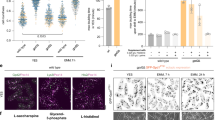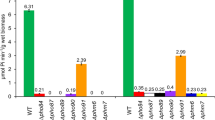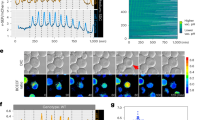Abstract
Two mutants which require phenylalanine for normal growth and which show no prephenate dehydratase activity in vitro have been found to accumulate and excrete phenylalanine when incubated on minimal medium or grown on low concentrations of phenylalanine. The high levels of phenylalanine accumulated in these mutants apparently cannot be used for protein synthesis or for the regulation of the biosynthetic enzymes in the aromatic pathway. Mutant mycelia grown in high phenylalanine maintain a much lower level of free phenylalanine in the cells than do those grown on low phenylalanine or those which eventually grow on minimal. If all the phenylalanine required for the protein in a 3-day mycelial pad is supplied, little or no phenylalanine can be found in the medium after 3 days: if only a fraction of the total protein phenylalanine is supplied, the concentration of phenylalanine in the medium after 3 days is actually higher than the initial concentration. It is proposed that the mutation in these organisms has resulted in abnormal compartmentation of the phenylalanine produced so it cannot be utilized by the cells until it has been excreted and transported back into the normal pool channels. In this case, the transport (exogenous) and protein synthesis pools would be involved. The abnormal mislocation of the phenylalanine in the cell might be a result of the diffusion of free prephenate to low pH regions in the cell where it is nonenzymatically converted to phenylpyruvate. If, however, the mutant prephenate dehydratase is active in vivo, the mutation must somehow affect the activity or stability of the enzyme in vitro and also cause the release of the end product in the wrong place in the cell. This might be expected if the normal wild-type prephenate dehydratase is directionally oriented, e.g., as a result of membrane association, to release the product into normal cell channels (protein synthesis pool) while such oriented release might not occur in the mutants.
Similar content being viewed by others
References
Baker, T. I. (1968). Phenylalanine-tyrosine biosynthesis in Neurospora crassa. Genetics 58351.
Beinart, H., Green, D. E., Hela, P., Hift, H., Von Korff, R. W., and Ramakrishnan, C. V. (1953). The acetate activating enzyme system of heart muscle. J. Biol. Chem. 20335.
Brooks, C. J., DeBusk, B. G., DeBusk, A. G., and Catcheside, D. E. A. (1972). A new class of p-fluorophenylalanine-resistant mutants in Neurospora crassa. Biochem. Genet. 6239.
Brooks, C. J., and DeBusk, A. G. (1973). Cellular compartmentation of aromatic amino acids in Neurospora crassa. I. Occupation of a protein synthesis pool by phenylalanine in Tyr-1 mutants. Biochem. Genet. 1091.
Catcheside, D. E. A. (1969). Prephenate dehydrogenase from Neurospora: Feedback activation by phenylalanine. Biochim. Biophys. Acta. 1414276.
Cerutti, P., and Guroff, G. (1965). Enzymatic formation of phenylpyruvic acid in Pseudomonas Sp(ATCC 11299a) and its regulation. J. Biol. Chem. 2403034.
El-Eryani, A. A. (1967). Genetic and biochemical studies on phenylalanine- and tyrosine-requiring mutants of Neurospora crassa. Genetics 56557 (abst.).
Halsall, D. M., and Doy, C. H. (1969). Studies concerning the biochemical genetics and physiology of activity and allosteric inhibition mutants of Neurospora crassa 3-deoxy-d-arabino-hexulosonate-7-phosphate synthase. Biochim. Biophys. Acta 185432.
Loftfield, R. B., and Eigner, E. A. (1963) A radioactive hydroxamate method for determining rates of amino acid activation. Biochem. Biophys. Res. Commun. 72373.
Metzenberg, R. L., and Mitchell, H. K. (1958). The biosynthesis of aromatic compounds by Neurospora crassa. Biochem. J. 68168.
Author information
Authors and Affiliations
Additional information
This work was supported, in part, by an Atomic Energy Commission grant to the Institute of Molecular Biophysics, The Florida State University, and by the Genetics Training Grant, funded by the National Institutes of Health. It contains, in part, data from the doctoral thesis of the senior author, who was supported by a Florida State University Nuclear Fellowship and by a Public Health Service Fellowship.
Rights and permissions
About this article
Cite this article
Brooks, C.J., DeBusk, B.G. & DeBusk, A.G. Cellular compartmentation of aromatic amino acids in Neurospora crassa. II. Synthesis and misplaced accumulation of phenylalanine in Phen-2 auxotrophs. Biochem Genet 10, 105–120 (1973). https://doi.org/10.1007/BF00485759
Received:
Revised:
Issue Date:
DOI: https://doi.org/10.1007/BF00485759




